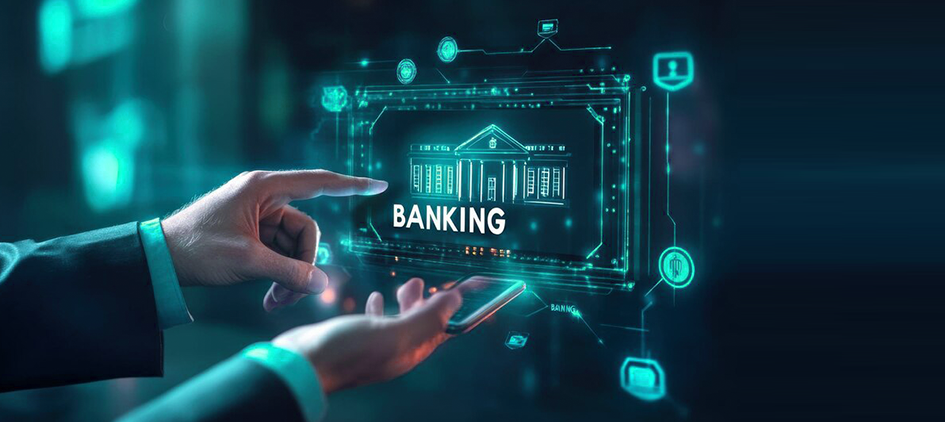
Top Trends in Core Banking Systems: Shaping the Future of Finance
The financial services industry is experiencing a significant evolution, driven by rapid technological advancements, changing customer expectations, and growing regulatory requirements. Core banking systems (CBS) the backbone of banking operations are no exception. These systems now adopt cutting-edge technologies like cloud computing, AI, and blockchain, allowing financial institutions to offer more efficient, secure, and personalized services.
This article delves deep into the top trends revolutionizing core banking systems and explores how they are shaping the future of the banking industry.
1. Cloud-Based Core Banking Systems: Flexibility and Scalability Redefined
 The migration to cloud-based core banking systems is one of the most transformative shifts in the financial sector. For decades, traditional banks operated with on-premise infrastructure that was costly to maintain, difficult to scale, and slow to adapt to technological advancements. The cloud changes that, offering banks a flexible, scalable, and cost-efficient solution to meet their growing needs.
The migration to cloud-based core banking systems is one of the most transformative shifts in the financial sector. For decades, traditional banks operated with on-premise infrastructure that was costly to maintain, difficult to scale, and slow to adapt to technological advancements. The cloud changes that, offering banks a flexible, scalable, and cost-efficient solution to meet their growing needs.
Why Cloud Adoption is So Important?
Cloud computing allows banks to scale on demand, meaning they can increase or decrease capacity based on real-time needs. This eliminates the need for overprovisioning resources, reduces waste, and lowers costs. Cloud platforms also offer enhanced disaster recovery options, ensuring that banks can restore critical operations faster in the event of downtime or cyberattacks.
Moreover, cloud-based solutions enable banks to respond to market changes with greater agility. For example, launching a new product or service on traditional infrastructure can take months, if not years. Cloud platforms allow these innovations to be deployed within days or weeks, giving banks a competitive edge.
The Future of Cloud-Based Core Banking Systems:
The trend toward cloud adoption in core banking systems is expected to accelerate in the coming years. Hybrid cloud models that blend private and public clouds are becoming increasingly popular for banks that want to balance security with scalability. Additionally, banking-as-a-service (BaaS) platforms built on cloud infrastructure will enable even smaller banks and fintechs to offer robust financial services without significant capital investment.
2. AI and Machine Learning Integration: Driving Automation and Personalization
 Artificial intelligence (AI) and machine learning (ML) are not just buzzwords—they fundamentally transform core banking systems. From fraud detection to personalized financial advice, AI and ML are embedded in nearly every aspect of banking.
Artificial intelligence (AI) and machine learning (ML) are not just buzzwords—they fundamentally transform core banking systems. From fraud detection to personalized financial advice, AI and ML are embedded in nearly every aspect of banking.
AI and ML Use Cases in Core Banking:
The Future of AI in Banking:
AI and ML will continue to evolve and become more sophisticated, enabling banks to automate more processes and improve decision-making. The next frontier in AI for core banking systems will likely involve predictive analytics to anticipate customer needs and behaviours, enhancing service quality and customer satisfaction.
3. APIs and Open Banking: Fostering Innovation and Collaboration
 The rise of APIs (Application Programming Interfaces) and open banking transforms the financial services landscape by creating a more open, collaborative ecosystem. Open banking refers to sharing financial data with third-party service providers (with customer consent), while APIs enable seamless integration between a bank’s core system and external applications.
The rise of APIs (Application Programming Interfaces) and open banking transforms the financial services landscape by creating a more open, collaborative ecosystem. Open banking refers to sharing financial data with third-party service providers (with customer consent), while APIs enable seamless integration between a bank’s core system and external applications.
How APIs and Open Banking Work:
APIs serve as building blocks that allow banks to open their systems to third-party developers. It enables the creation of innovative financial products that interact with core banking systems. For example, fintech companies can develop apps that aggregate account information from different banks, allowing customers to manage their finances from a single interface.
Benefits of APIs and Open Banking:
The Future of APIs in Core Banking:
As open banking continues to evolve, the banking sector will likely see a proliferation of API-driven ecosystems. Banks that adopt a platform model—where third-party services are easily integrated into their core systems—will benefit from increased customer engagement and new revenue streams. Banking-as-a-platform (BaaP) models will dominate, allowing banks to offer traditional financial services and an entire suite of digital products.
4. Embedded Finance: Banking Wherever You Are
 Embedded finance is redefining how and where financial services are delivered. Instead of directly interacting with a bank for financial needs, embedded finance integrates banking functions like lending, payments, and insurance into non-financial platforms. For example, a customer might obtain a loan while making an online purchase or buy insurance through a ride-sharing app.
Embedded finance is redefining how and where financial services are delivered. Instead of directly interacting with a bank for financial needs, embedded finance integrates banking functions like lending, payments, and insurance into non-financial platforms. For example, a customer might obtain a loan while making an online purchase or buy insurance through a ride-sharing app.
Key Use Cases of Embedded Finance:
The Impact on Core Banking Systems:
For banks, embedded finance opens up many opportunities to reach customers outside traditional banking channels. Core banking systems must adapt by becoming API-centric and flexible enough to integrate into various non-banking platforms.
The Future of Embedded Finance:
As more industries adopt embedded finance solutions, banks will need to find ways to seamlessly integrate their services into everyday experiences. This trend is expected to grow rapidly, as it offers convenience to consumers and new revenue streams for financial institutions.
5. Real-time Data Processing and Analytics: Enabling Instant Decisions
 Today’s customers expect real-time banking services, from instant payments to immediate balance updates. Real-time data processing is becoming a critical feature of modern core banking systems, allowing banks to process transactions, update balances, and provide analytics instantaneously.
Today’s customers expect real-time banking services, from instant payments to immediate balance updates. Real-time data processing is becoming a critical feature of modern core banking systems, allowing banks to process transactions, update balances, and provide analytics instantaneously.
Key Benefits of Real-Time Data Processing:
The Future of Real-Time Data Processing:
Real-time capabilities will expand in core banking systems as streaming data platforms become more powerful. Banks that invest in real-time data processing will gain a competitive edge by being more responsive to customer needs and market dynamics.
6. Cybersecurity and Compliance: The Pillars of Trust
 As core banking systems become increasingly digital and interconnected, the importance of cybersecurity and regulatory compliance has never been greater. With more data being processed in real-time and open APIs exposing banks to new external risks, customer data security and privacy are paramount.
As core banking systems become increasingly digital and interconnected, the importance of cybersecurity and regulatory compliance has never been greater. With more data being processed in real-time and open APIs exposing banks to new external risks, customer data security and privacy are paramount.
Key Cybersecurity Threats Facing Core Banking:
Compliance and Regulation:
Global regulations like GDPR (General Data Protection Regulation) and local laws mandate that banks protect customer data and maintain transparency in their operations. Non-compliance can result in hefty fines and reputational damage. Core banking systems must integrate compliance frameworks that help banks monitor and enforce security policies in real-time.
The Future of Cybersecurity in Core Banking:
In the future, banks will leverage AI and ML to enhance their cybersecurity defences. For example, AI can analyze transaction data to detect anomalies that indicate fraud. Biometric authentication such as fingerprint or facial recognition will become more prevalent, providing an additional layer of security.
7. Digital Transformation and Customer-Centricity: Adapting to Modern Expectations
 Digital transformation in core banking systems is driven by the demand for more customer-centric services.
Digital transformation in core banking systems is driven by the demand for more customer-centric services.
Today’s customers expect convenience, personalization, and seamless banking experiences across all devices and touchpoints.
Key Aspects of Digital Transformation:
The Future of Digital Transformation:
The focus on customer-centric banking will only intensify in the coming years. Core banking systems will need to adapt to new technologies, such as voice banking and augmented reality, that provide more intuitive ways for customers to interact with their financial services.
8. Blockchain and Distributed Ledger Technology (DLT): Revolutionizing Transactions
 Blockchain and Distributed Ledger Technology (DLT) fundamentally change how financial transactions are recorded and verified. While blockchain is most commonly associated with cryptocurrencies, its impact on core banking systems is far-reaching, offering greater transparency, efficiency, and security.
Blockchain and Distributed Ledger Technology (DLT) fundamentally change how financial transactions are recorded and verified. While blockchain is most commonly associated with cryptocurrencies, its impact on core banking systems is far-reaching, offering greater transparency, efficiency, and security.
Blockchain Applications in Core Banking:
The Future of Blockchain in Core Banking:
While still in its early stages, blockchain is poised to revolutionize the financial industry. As central banks and governments explore the potential of Central Bank Digital Currencies (CBDCs) core banking systems must integrate blockchain technologies to handle digital currencies and enhance transparency in financial transactions.
9. Microservice Architecture: The Future of Agile Banking
 Banks are increasingly adopting microservice architectures to replace their legacy, monolithic systems. Unlike traditional systems, where all components are tightly coupled, microservice architectures break down applications into smaller, independent services that can be developed, deployed, and scaled separately.
Banks are increasingly adopting microservice architectures to replace their legacy, monolithic systems. Unlike traditional systems, where all components are tightly coupled, microservice architectures break down applications into smaller, independent services that can be developed, deployed, and scaled separately.
Benefits of Microservices in Core Banking:
The Future of Microservice Architecture:
As the financial industry evolves, microservice architectures will become the foundation of modern core banking systems. They offer the agility needed to keep up with rapid technological changes, enabling banks to deliver better customer services.
10. Digital Currencies and Central Bank Digital Currencies (CBDCs): The Future of Money
 As digital payments become the norm, central banks are exploring the creation of Central Bank Digital Currencies (CBDCs). These digital currencies are intended to complement physical cash and offer a more efficient, secure, and transparent form of money.
As digital payments become the norm, central banks are exploring the creation of Central Bank Digital Currencies (CBDCs). These digital currencies are intended to complement physical cash and offer a more efficient, secure, and transparent form of money.
Benefits of CBDCs:
The Future of CBDCs:
As more countries experiment with digital currencies, banks must adapt their core systems to integrate with CBDCs. It will require enhanced security, real-time data processing, and new standards for digital asset management
Conclusion
A variety of technological advancements and market demands are shaping the future of core banking systems. From the flexibility of cloud computing to the transformative potential of blockchain, these trends are revolutionizing how banks operate and interact with customers. Financial institutions that embrace these changes and invest in modern core banking systems will be better positioned to thrive in the digital age.
How Can Datavision help?
We assist various financial institutions and global banks on their digital transformation journey. Our one-of-a-kind approach, which combines people, process, and technology, expedites the delivery of superior results to our clients and drives excellence. Several reputed companies leverage our proprietary suite of business excellence tools and services to unlock new growth levers and unparalleled ROI.
Datavision stands proudly as a prominent banking software solutions provider, recognized for our unwavering commitment to excellence in the industry. We have earned our esteemed reputation by consistently delivering cutting-edge core banking software, catering to the needs of both retail and corporate banking software sectors. At Datavision, our mission is clear: to provide our clients with the best banking software products, ensuring that they stay ahead in an ever-evolving financial landscape. We take pride in serving our prestigious clients and look forward to continuing our journey of innovation and excellence.
Our portfolio of banking software product and services include:
Core Banking Solutions: | FinNext Core | Banking: | FinTrade | EasyLoan | MicroFin |
Digital Banking Solutions: | IBanc | MobiBanc | MBranch | FinTab | FinSight |
Risk & Compliance: |FinTrust |
Want to know how our team of experts at Datavision provides customizable, scalable, and cost-effective banking software products and solutions to our esteemed clients? Visit us for more information.